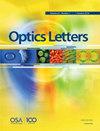柔性强度与自由光学波前整形。
IF 3.3
2区 物理与天体物理
Q2 OPTICS
引用次数: 0
摘要
用自由曲面光学同时塑造光强和光波前在许多应用中具有重要的潜力。然而,在倾斜几何形状中,柔性强度和波前整形(例如,用工程自由波前产生预定义强度)仍然是一个未解决的问题。在这里,我们提出了一种直接的方法,该方法建立在用于点源强度裁剪的monge - ampantere方法的基础上,以解决这个问题。这种直接的方法可以在具有两个自由曲面的倾斜几何中实现灵活的强度和波前整形。通过仿真和实验验证了该方法的有效性。本文章由计算机程序翻译,如有差异,请以英文原文为准。
Flexible intensity and wavefront shaping with freeform optics.
Simultaneously shaping both the luminous intensity and the wavefront of light with freeform optics holds significant potential across numerous applications. However, flexible intensity and wavefront shaping (e.g., generating a predefined intensity with an engineered freeform wavefront) in tilted geometries remains an unresolved problem. Here, we propose a direct method that is built upon the Monge-Ampère method developed for point-source intensity tailoring to address this problem. This direct method enables flexible intensity and wavefront shaping in tilted geometry with two freeform surfaces. Two examples are given to validate this method via both simulation and experimental tests.
求助全文
通过发布文献求助,成功后即可免费获取论文全文。
去求助
来源期刊

Optics letters
物理-光学
CiteScore
6.60
自引率
8.30%
发文量
2275
审稿时长
1.7 months
期刊介绍:
The Optical Society (OSA) publishes high-quality, peer-reviewed articles in its portfolio of journals, which serve the full breadth of the optics and photonics community.
Optics Letters offers rapid dissemination of new results in all areas of optics with short, original, peer-reviewed communications. Optics Letters covers the latest research in optical science, including optical measurements, optical components and devices, atmospheric optics, biomedical optics, Fourier optics, integrated optics, optical processing, optoelectronics, lasers, nonlinear optics, optical storage and holography, optical coherence, polarization, quantum electronics, ultrafast optical phenomena, photonic crystals, and fiber optics. Criteria used in determining acceptability of contributions include newsworthiness to a substantial part of the optics community and the effect of rapid publication on the research of others. This journal, published twice each month, is where readers look for the latest discoveries in optics.
 求助内容:
求助内容: 应助结果提醒方式:
应助结果提醒方式:


